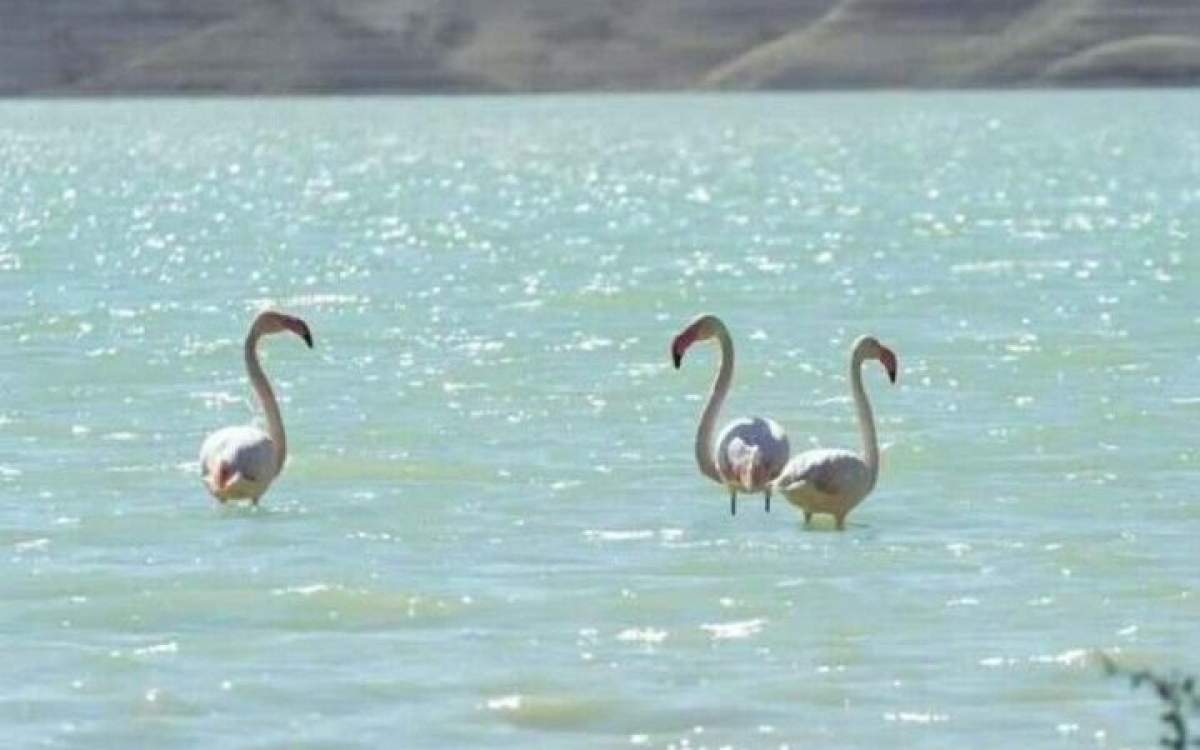The Iran Project
: On their way to cold regions, flamingos have been spotted at reservoirs in North Khorasan Province, an official with the Department of Environment (DOE) has said.
Sunday 7 April 2024 - 22:43
Story Code : 419104
Source : Tehran Times
Migratory flamingoes land in North Khorasan reservoirs
They have landed on the lake and dams in the northeast of the country to feed themselves. The flamingoes are expected to depart from the area in the next 20 days, IRNA quoted Mohammad Taqdisi as saying.
Flamingoes in Barzo Dam, Golil Dam, and Atrak River migrate to Siberia as the weather gets warm.
Migratory Flamingos have arrived in Shirvan, a city in North Khorasan Province. They are expected to be seen in Golil Lake in the next ten days; the lake is frozen now.
Last year, which ended on March 19, eight species of birds and waterside birds involving 550 birds were recorded in Barzo Dam. The majority of the birds were mallards, common teal, and grey herons.
Thanks to favorable living conditions, a number of mallards have not left the dam and are expected to lay eggs in April.
Flamingos are a type of wading bird in the family Phoenicopteridae. They have long legs, long slender necks, white and pink feathers, and wings.
This graceful bird walks slowly and feeds by dipping its head and beak into shallow water. They can be 90 to 159 centimeters tall. Flamingoes mostly consume snails and aquatic plants.
They are very social birds; they live in colonies whose population can number in the thousands.
These large colonies are believed to serve three purposes for the flamingos: avoiding predators, maximizing food intake, and using scarcely suitable nesting sites more efficiently. Before breeding, flamingo colonies split into breeding groups of about 15 to 50 birds.
Iran hosts over 5% of world's wintering birds
Iran hosts more than five percent of the world's migratory birds in 450 sites in winter, the Department of Environment’s director for natural environment and biodiversity has said.
Encompassing numerous wetlands, reservoirs, and diverse water bodies, Iran welcomes millions of migratory birds every year. It is a wintering home for more than 1.8 million birds of 166 species, IRNA quoted Hassan Akbari as saying.
The census on water birds is conducted in more than 100 countries of the world with the participation of about 15,000 professional and volunteer birdwatchers, he said, adding, “Every year some 30 to 40 million birds are counted all over the world and the related statistics are recorded in the International Waterfowl Census (IWC) database.”
The IWC is the oldest, most comprehensive, and longest-running biodiversity monitoring program in the world.
The number of birds is counted in wetlands and areas where wintering water birds gather. The collected data and related analyses have significant scientific value in protecting wetlands, beaches, and biodiversity, he added.
Iran joined the international census of wintering water birds as the first West Asian country at the same time as European countries in 1976.
In the early years, the counting of water birds was limited to the species that could be hunted including swans, geese, ducks, and common terns. Since 1987, other aquatic birds have been added to the list.
Pointing out that in the past 6 decades, the counting of wintering water birds in Iran has been a priority of the Department of Environment, he added, “Thanks to favorable geographical conditions, climatic diversity, wetlands, and aquatic habitats, including the Caspian Sea in the north, the Persian Gulf and the Oman Sea in the south, Iran hosts millions of migratory and wintering water birds yearly.”
Iran is considered the most important country providing valuable wintering habitats for birds on their migration route from Siberia to the Nile. Over 10 million migrant birds are estimated to take this route.
The annual census for migratory birds in Iran begins in the middle of the Iranian calendar month of Dey (December 22-January 20) and ends in the middle of the month of Bahman (January 21-February 19) in more than 450 sites in 30 provinces with the help of headquarters, provincial experts and professional birdwatchers of non-governmental organizations.
The results of the Iranian water bird population census showed that in the last five decades, more than 77 million water birds of 166 different species were observed and recorded in more than 970 census sites. In the last three decades, over 8.1 million birds were counted on average, which is about five percent of the world migratory bird’s population and more than 16 percent of the population of the migrant birds taking the route from Siberia to the Nile.
The statistical analysis of the changes in the total number of water birds has indicated a stable trend and a slight increase in the population of wintering birds in the last 35 years. About half of Iran's waterfowl population is counted in the shores and coastal wetlands of the Caspian Sea, and the rest is more or less equal in the inland water areas and southern provinces.
Reporter : Editorial of The Iran Project
# Tags











